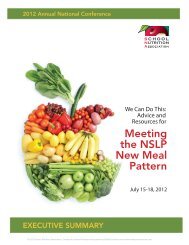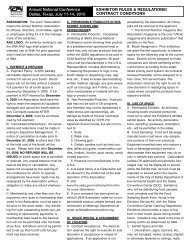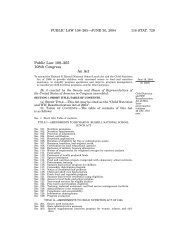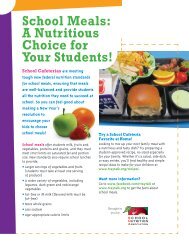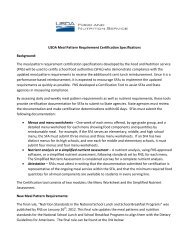Over the past several months it has become evident that the total US ...
Over the past several months it has become evident that the total US ...
Over the past several months it has become evident that the total US ...
Create successful ePaper yourself
Turn your PDF publications into a flip-book with our unique Google optimized e-Paper software.
SPECIAL EDITION – SPRING 2008<br />
®<br />
<strong>Over</strong> <strong>the</strong> <strong>past</strong> <strong>several</strong> <strong>months</strong> <strong>it</strong> <strong>has</strong> <strong>become</strong> <strong>evident</strong> <strong>that</strong> <strong>the</strong> <strong>total</strong> U.S. economic picture <strong>has</strong> <strong>become</strong><br />
more cloudy. The sub-prime loan collapse, coupled w<strong>it</strong>h falling housing prices and rising energy costs,<br />
<strong>has</strong> pushed <strong>the</strong> economy toward a significant slowdown. For <strong>the</strong> foodservice industry, <strong>the</strong> result <strong>has</strong><br />
<strong>become</strong> slowing traffic and fewer customers which translate into slowing sales. Add in skyrocketing<br />
commod<strong>it</strong>y and food costs, and <strong>the</strong> foodservice operator is really feeling <strong>the</strong> pinch.<br />
This special ed<strong>it</strong>ion of Tyson Insights & Discovery newsletter explains some of <strong>the</strong> economic and<br />
foodservice factors causing <strong>the</strong>se tougher times and <strong>the</strong>ir impacts. More importantly, specific ideas and<br />
measures are suggested to operators in order to better pos<strong>it</strong>ion <strong>the</strong>m to wea<strong>the</strong>r <strong>the</strong> tougher times.<br />
Insights & Discovery is produced by Tyson Food Service Marketing in collaboration w<strong>it</strong>h Technomic, a fact-based food industry marketing<br />
Insights research & and Discovery consulting is produced firm. This by information Technomic, cannot Inc., <strong>the</strong> be leading distributed provider or duplicated of consulting w<strong>it</strong>hout and <strong>the</strong> research express<br />
to wr<strong>it</strong>ten <strong>the</strong> restaurant approval industry. of Tyson Foods, Inc.<br />
© 2008 Tyson Foods, Inc.<br />
1
33%<br />
10%<br />
The Economic Slump<br />
The U.S. economy <strong>has</strong> a direct impact on all industries, and foodservice is no exception. The key measure for <strong>the</strong> economy<br />
is Gross Domestic Product or GDP. Manufacturers GDP is <strong>the</strong> value of all goods and services Operators produced in <strong>the</strong> Un<strong>it</strong>ed States, which currently<br />
stands at about $14 trillion dollars annually. <strong>Over</strong> <strong>the</strong> <strong>past</strong> 5 years, GDP quarterly growth <strong>has</strong> averaged about 3%. However, for<br />
<strong>the</strong> 4th quarter of 2007, growth slowed considerably to a meager 0.6%.<br />
Ano<strong>the</strong>r economic factor <strong>that</strong> is cr<strong>it</strong>ical to <strong>the</strong> foodservice industry’s health is disposable personal income or DPI. DPI is <strong>the</strong><br />
amount of money consumers have in <strong>the</strong>ir pockets after paying taxes. Historical data suggest <strong>the</strong>re is a strong correlation<br />
between <strong>the</strong> foodservice industry and DPI growth, and this fact is relatively intu<strong>it</strong>ive. If consumers have more money, <strong>the</strong>y have<br />
more discretionary dollars to spend on Foodservice affordable Industry luxuries Growth such as (% meals Change prepared vs. Prior away-from-home. Year) Ano<strong>the</strong>r sign of economic<br />
weakness and concern for foodservice is <strong>that</strong> DPI slumped to <strong>it</strong>s lowest level in 2 years in <strong>the</strong> latest reporting period.<br />
Looking 6.0% forward, <strong>the</strong>re does not seem to be much optimism about <strong>the</strong> state of <strong>the</strong> U.S. economy. Two special surveys have<br />
been conducted w<strong>it</strong>h both foodservice manufacturers and operators, asking each group about <strong>the</strong>ir optimism regarding <strong>the</strong> U.S.<br />
economy 5.0% over <strong>the</strong> next 12 <strong>months</strong>. It is apparent <strong>that</strong> both operator and manufacturer optimism for <strong>the</strong> economy is considerably<br />
lower today compared to recent previous periods.<br />
4.0%<br />
% Optimistic About <strong>the</strong> U.S. Economy <strong>Over</strong> <strong>the</strong> Next 12 Months<br />
3.0%<br />
August 2006<br />
48%<br />
2.0%<br />
46%<br />
August 2007<br />
43%<br />
43%<br />
1998 1999 2000 2001 2002 2003 2004 2005 February 2006 2008 2007 (P) 2008 (F)<br />
33%<br />
8.0%<br />
6.0%<br />
10%<br />
Producer Price Index – Food<br />
4.0%<br />
Manufacturers<br />
Operators<br />
2.0%<br />
Source: Technomic Surveys<br />
For 0.0% <strong>the</strong> foreseeable future, economists are pessimistic on <strong>the</strong> economic state, w<strong>it</strong>h many predicting an actual decline in GDP in<br />
<strong>the</strong> first half of 2008, which would technically plunge <strong>the</strong> economy into a recession for <strong>the</strong> first time since 2002.<br />
-2.0%<br />
J F M A M J J A S O N D J F M A M J J A S O N D J F M A M J J A S O N D J<br />
Softness In The Foodservice Industry<br />
2005<br />
Foodservice Industry Growth 2006 (% Change vs. Prior Year) 2007<br />
Not surprisingly, <strong>the</strong> economic slowdown <strong>has</strong> impacted <strong>the</strong> foodservice industry negatively. Less consumer spending overall<br />
<strong>has</strong> translated into lower spending on meals away-from-home. Technomic’s 12 month moving average, a barometer tracking<br />
6.0%<br />
<strong>the</strong> health of <strong>the</strong> foodservice industry, <strong>has</strong> shown a steady decline in <strong>the</strong> industry since July 2007.<br />
5.0%<br />
12 Month Moving Average Restaurant Growth (% Change vs. Prior Year)<br />
6.0% 4.0%<br />
5.0% 3.0%<br />
4.0% 2.0%<br />
1998 1999 2000 2001 2002 2003 2004 2005 2006 2007 (P) 2008 (F)<br />
3.0%<br />
2.0%<br />
Producer Price Index – Food<br />
8.0% N D J F M A M J J A S O N D J F M A M J J A S O N<br />
2005<br />
6.0%<br />
2006 2007<br />
Source: U.S. Census Bureau; Technomic, Inc.<br />
4.0%<br />
<br />
© 2008 Tyson Foods, Inc.
33%<br />
% Optimistic About <strong>the</strong> U.S. Economy <strong>Over</strong> <strong>the</strong> Next 12 Months<br />
10%<br />
All areas of <strong>the</strong> industry have been impacted, but some have been impacted more than o<strong>the</strong>rs. August Full 2006 service restaurants have<br />
been hurt by consumers trading 48% down to less costly foodservice venues, 46% such as fast food restaurants.<br />
August 2007<br />
In add<strong>it</strong>ion, many<br />
consumers, when vis<strong>it</strong>ing full service Manufacturers 43% restaurants, are skipping extras such Operators 43% as appetizers, desserts and alcoholic beverages. The<br />
February 2008<br />
business & industry segment is struggling as company cutbacks and layoffs occur, leaving smaller populations to serve.<br />
33%<br />
As such, Technomic, Inc., <strong>the</strong> industry’s forecasters, believe this year will be a trying year for foodservice sales. Comparatively,<br />
2008 is expected to be <strong>the</strong> weakest for growth since 2003.<br />
10%<br />
Foodservice Industry Growth (% Change vs. Prior Year)<br />
6.0%<br />
5.0%<br />
4.0%<br />
Manufacturers<br />
Operators<br />
3.0%<br />
Foodservice Industry Growth (% Change vs. Prior Year)<br />
2.0%<br />
6.0%<br />
1998 1999 2000 2001 2002 2003 2004 2005 2006 2007 (P) 2008 (F)<br />
Source: Technomic, Inc.<br />
5.0%<br />
P = Preliminary<br />
F = Forecasted<br />
Producer Price Index – Food<br />
4.0%<br />
8.0%<br />
Rising Food Costs<br />
3.0% 6.0%<br />
Food cost increases are causing pain for virtually every link in <strong>the</strong> foodservice channel. The producer price index or PPI for food,<br />
2.0%<br />
<strong>the</strong> key<br />
4.0%<br />
food cost inflation measure, <strong>has</strong> risen to consistently higher levels over <strong>the</strong> <strong>past</strong> year, and continues to do so in early<br />
2008. 1998<br />
2.0% As of <strong>the</strong> latest 1999 reporting 2000 period (January 2001 2008), 2002 <strong>the</strong> PPI for 2003 food rose 2004 8.3% compared 2005 to January 2006 2007. 2007 (P) 2008 (F)<br />
0.0%<br />
-2.0%<br />
Producer Price Index – Food<br />
8.0%<br />
J F M A M J J A S O N D J F M A M J J A S O N D J F M A M J J A S O N D J<br />
6.0%<br />
2005<br />
2006 2007<br />
4.0%<br />
2.0%<br />
12 Month Moving Average Restaurant Growth (% Change vs. Prior Year)<br />
0.0%<br />
6.0%<br />
-2.0%<br />
5.0% J F M A M J J A S O N D J F M A M J J A S O N D J F M A M J J A S O N D J<br />
2005<br />
2006 2007<br />
4.0%<br />
Base: 3.0% Bureau of Labor Statistics<br />
12 Month Moving Average Restaurant Growth (% Change vs. Prior Year)<br />
2.0%<br />
6.0%<br />
N D J F M A M J J A S O N D J F M A M J J A S O N<br />
5.0% 2005 2006 2007<br />
4.0%<br />
<br />
© 2008 Tyson Foods, Inc.
Food price increases are being driven by a number of factors:<br />
• Compet<strong>it</strong>ion for corn from biofuels, which are subsidized significantly, reducing available supply for food and<br />
animal feed applications.<br />
• Farmers sw<strong>it</strong>ching to corn from o<strong>the</strong>r crops, such as soybeans, wheat, and o<strong>the</strong>r grains, taking advantage of<br />
corn subsidies. Less available land for <strong>the</strong>se o<strong>the</strong>r crops means tightening supplies.<br />
• Growing wealth of emerging economies and rising standards of living in countries such as China and o<strong>the</strong>r<br />
developing countries, which are pushing up demand for various food commod<strong>it</strong>ies.<br />
• Recent sub-standard growing seasons in o<strong>the</strong>r agricultural countries such as Australia and <strong>the</strong> Ukraine,<br />
resulting in less global supply.<br />
• Higher cost of fuel and energy necessary for producing, processing and transporting food, which are passed<br />
along down <strong>the</strong> channel.<br />
All of <strong>the</strong> above have combined to cause significant pain in <strong>the</strong> industry. It’s a simple equation of economics: less supply and<br />
greater demand translates into higher prices. Since an extremely high percentage of foods are made and animals are fed<br />
w<strong>it</strong>h <strong>the</strong>se commod<strong>it</strong>ies, higher prices are impacting almost every food category.<br />
Foodservice operators have not been spared and are feeling <strong>the</strong> pinch of higher food costs. In a recent survey conducted by<br />
Technomic w<strong>it</strong>h foodservice operators, more than three-quarters of foodservice operators report <strong>that</strong> <strong>the</strong>ir food and beverage<br />
costs have on average increased 8% versus <strong>the</strong> previous year. In fact, <strong>the</strong> number one operator concern today is rising food<br />
costs. O<strong>the</strong>r cost increases related to healthcare, energy and labor are only compounding operator pain.<br />
What To Do?<br />
Primary Operator Concerns<br />
Issue<br />
% Concerned<br />
Rising Food Costs 82%<br />
Rising Healthcare Costs 77<br />
Rising Energy Costs 77<br />
Rising Labor Costs 73<br />
Inabil<strong>it</strong>y to Grow Prof<strong>it</strong>s 71<br />
Base: Technomic Operator Survey<br />
The economic picture and cost s<strong>it</strong>uation have combined to cause a “perfect storm” in <strong>the</strong> industry: slowing growth plus<br />
higher costs equals less prof<strong>it</strong>. This “stagflation” s<strong>it</strong>uation <strong>has</strong> resulted in concern among all in <strong>the</strong> industry, and <strong>the</strong> question<br />
arises, “What can we do?” There are a number of different tactics and strategies foodservice operators can employ in <strong>the</strong>se<br />
tough times to wea<strong>the</strong>r <strong>the</strong> storm. A number of examples are listed below.<br />
.<br />
.<br />
In<strong>it</strong>iate or increase frequency of deals. As consumers have less money in <strong>the</strong>ir pockets, <strong>the</strong>y are more sens<strong>it</strong>ive to<br />
special incentives when selecting where and what to eat. Offering special deals or bundled meals to consumers are triedand-true<br />
measures to help drive traffic. The fear among many operators is <strong>that</strong> deals will decrease margins significantly,<br />
rendering <strong>the</strong>m not worth <strong>the</strong> effort. However, sophisticated operators realize deals <strong>that</strong> get customers through <strong>the</strong> door<br />
are just a first step; once this is accomplished, using point of sale and suggestive selling allows for upselling to raise <strong>the</strong><br />
transaction values.<br />
Install a Two-Tier Pricing Strategy. A number of operators have inst<strong>it</strong>uted a two-tier pricing strategy to drive traffic.<br />
At one end of <strong>the</strong> spectrum are “normally” priced products <strong>that</strong> often include complete meals. At <strong>the</strong> o<strong>the</strong>r end are<br />
value-priced <strong>it</strong>ems <strong>that</strong> often just include one component of a meal and/or a smaller size (e.g., mini-sandwich). These<br />
<br />
© 2008 Tyson Foods, Inc.
value-priced <strong>it</strong>ems are ano<strong>the</strong>r means of driving traffic, providing operators w<strong>it</strong>h an opportun<strong>it</strong>y to upsell customers when<br />
ordering.<br />
.<br />
.<br />
Continue new menu development efforts. One of <strong>the</strong> first reactions of many operators is to pull back on tweaking <strong>the</strong><br />
menu in tough times. This natural instinct is driven by <strong>the</strong> necess<strong>it</strong>y of purc<strong>has</strong>ing add<strong>it</strong>ional products and ingredients for a<br />
new menu <strong>it</strong>em <strong>that</strong> may not meet sales expectations, resulting in wasted costs. If executed correctly, new <strong>it</strong>em in<strong>it</strong>iatives<br />
add exc<strong>it</strong>ement to <strong>the</strong> menu and offer opportun<strong>it</strong>ies to increase traffic. The keys to successful new product introductions<br />
are <strong>the</strong> same in tough times as in good: offering products <strong>that</strong> are on-trend w<strong>it</strong>h <strong>the</strong> operator’s target clientele base and<br />
promoting new <strong>it</strong>ems via in-operation merchandising and external promotions. Also, as compet<strong>it</strong>ors may pull back on new<br />
menu development, involvement here may serve as a point of pos<strong>it</strong>ive differentiation in <strong>the</strong> customer’s mind.<br />
Don’t Be Afraid to Raise Menu Prices. There is often reluctance among operators to raise menu prices, especially when<br />
traffic slows down. Operators fear <strong>that</strong> menu price increases will alienate customers and cause <strong>the</strong>m to eat elsewhere. In<br />
<strong>the</strong> current environment, however, <strong>it</strong> will be difficult for operators NOT to increase menu prices. Higher food costs, coupled<br />
w<strong>it</strong>h o<strong>the</strong>r cost increases in healthcare, energy and labor, will necess<strong>it</strong>ate <strong>that</strong> operators review <strong>the</strong>ir menu pricing. In fact,<br />
many are already doing so. Based on a recent operator survey conducted by Technomic, over half of operators have raised<br />
menu prices over <strong>the</strong> <strong>past</strong> six <strong>months</strong> and plan to do so again in <strong>the</strong> next six <strong>months</strong>. On average, <strong>the</strong>se operators have<br />
and/or are planning to increase <strong>the</strong>ir menu prices by 5% during each of <strong>the</strong>se 6 month time frames.<br />
Implications<br />
Operator Menu Price S<strong>it</strong>uation<br />
Time Frame<br />
% Increasing<br />
Menu Prices<br />
Average<br />
Increase<br />
W<strong>it</strong>hin <strong>the</strong> Last Six Months 53% 5%<br />
W<strong>it</strong>hin <strong>the</strong> Next Six Months 55% 5%<br />
Base: Technomic Operator Survey<br />
Before taking a price increase, operators should research how <strong>the</strong>ir compet<strong>it</strong>ors are pricing on <strong>the</strong>ir menus, so <strong>that</strong> <strong>the</strong><br />
appropriate magn<strong>it</strong>ude of any increase can be determined.<br />
5. Don’t Sacrifice Qual<strong>it</strong>y for Price. One common error during tough times is operators reassessing <strong>the</strong>ir food ingredient<br />
and component needs, and trading down to lower priced, lower qual<strong>it</strong>y goods across-<strong>the</strong>-board. Significant risks are present<br />
in doing so, most notably <strong>the</strong> risk of alienating current customers by producing inferior qual<strong>it</strong>y menu <strong>it</strong>ems. However, <strong>it</strong><br />
might be a good option in some circumstances to slightly downgrade for lesser costs in some categories if this doesn’t<br />
negatively impact qual<strong>it</strong>y and disappoint customers.<br />
.<br />
.<br />
.<br />
.<br />
.<br />
The economy is expected to slow considerably, at least for <strong>the</strong> first half of 2008. DPI, <strong>the</strong> key foodservice indicator, is falling, meaning<br />
<strong>that</strong> consumers have less money to spend overall. Operators should revise <strong>the</strong>ir expectations for sales and traffic appropriately.<br />
Although <strong>the</strong> industry is slowing, consumers will continue to purc<strong>has</strong>e meals away-from-home, however <strong>the</strong>y will shift to lower<br />
priced venues, and have a propens<strong>it</strong>y to skip extras. Depending on <strong>the</strong> operation, <strong>it</strong> may be prudent to begin offering a lim<strong>it</strong>ed set<br />
of value priced <strong>it</strong>ems and increase dealing activ<strong>it</strong>y to drive traffic.<br />
Food cost increases are a real<strong>it</strong>y, and significant reduction of prices is not expected in <strong>the</strong> foreseeable future. Look to improve on<br />
your yield and internal systems to use ingredients and components more efficiently. Taking a price increase is also a viable option,<br />
as compet<strong>it</strong>ors most likely will as well.<br />
Menu development and promotional strategies should be intensified as a means of driving traffic and differentiating from customers.<br />
Realize <strong>the</strong> goal of any dealing is to drive traffic, as well as upsell once consumers come through <strong>the</strong> door.<br />
Desp<strong>it</strong>e all <strong>the</strong> economic and cost issues, <strong>the</strong>re is cause for optimism. The foodservice industry is one <strong>that</strong> <strong>has</strong> historically come out<br />
of economic downturns more quickly than o<strong>the</strong>r industries. We see no reason why this episode should be any different.<br />
<br />
© 2008 Tyson Foods, Inc.



